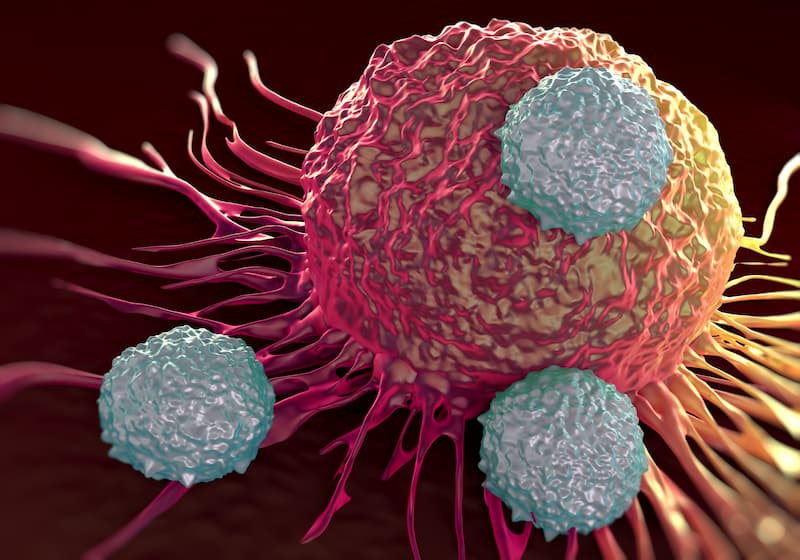ICIs May be a Safe Option in Cancer Regardless of HIV Diagnosis
Patients with human immunodeficiency virus and cancer may derive clinical benefit from immune checkpoint inhibition with no excess toxicity in non–small cell lung cancer and other cancers.
Patients with human immunodeficiency virus (HIV) experienced differential outcomes with no increase in toxicity compared with those without HIV when treated with immune checkpoint inhibitors (ICIs) for metastatic non–small cell lung cancer (NSCLC) and other types of cancer, according to a retrospective study published recently in the Journal of Clinical Oncology.
"In this large real-world cohort of patients with HIV receiving ICIs for various cancer types, we build on prior efforts and demonstrate that [these patients] have no excess or unexpected treatment-related immune toxicities compared with historical and matched controls without HIV," according to the study authors.

When comparing patients with and without HIV who received ICI therapy for metastatic NSCLC, the adjusted difference in restricted mean survival time (RMST) within 42 months was 2.23 months (95% CI, –4.0 to 8.5; P = .48) for overall survival (OS) and –0.06 months (95% CI, –5.5 to 5.4; P = .98) for progression-free survival (PFS). The OS rate at 24 months was 42.3% among patients with HIV vs 41.5% for those without; the corresponding figures for PFS were 17.8% and 18.4%, respectively. Patients with HIV had an overall response rate (ORR) of 28% and patients without HIV had an ORR of 36% (P = .31).
The toxicity profiles were also similar for patients with and without HIV. Immune-related adverse effects (IRAEs) of any grade occurred in 20% of patients with HIV and NSCLC vs 22% of similar patients without HIV. IRAEs of grade 3 or higher occurred in 12.0% vs 9.1% of patients, respectively.
Across 390 patients with HIV receiving ICIs for cancer, the incidence of IRAEs was 20%. In 91% of patients with available data, the median time to IRAE onset was 8.1 weeks. Moreover, there were no significant changes in CD4-positive T-cell counts (n = 74; P = .19) or HIV viral load (n = 107; P = .97) during ICI treatment.
“Although recent advocacy efforts have successfully increased the enrollment of patients with HIV in clinical trials, [these patients] have been historically excluded from the majority of the trials, including those with ICIs,” the investigators wrote. “In this large real-world cohort of patients with HIV receiving ICIs for various cancer types, we build on prior efforts and demonstrate that [these patients] have no excess or unexpected treatment-related immune toxicities compared with historical and matched controls without HIV.”
Investigators of the retrospective, multicenter database analysis collected data on patients with HIV treated with ICIs. The whole population served as the basis for the safety analysis in cohort A, whereas the efficacy analysis in this cohort included 378 patients of the total population. In cohort B, investigators compared outcomes among 61 patients with HIV and NSCLC drawn from the overall population vs 110 matched patients without HIV.
The median patient age was 58 years (interquartile range [IQR], 51-63), and 85% were male in cohort A. Most patients were either White (54%) or Black (36%). Additionally, 14% of the population was Hispanic or Latinx. The median time between HIV and cancer diagnosis was 17 years (IQR, 6.7-24).
All patients received at least 1 dose of an ICI, and the majority (70%) received anti–PD-1 or anti–PD-L1 monotherapy. Among patients with data available, most (70%) had a CD4-positive T-cell count of at least 200 cells/mL, and most (63%) had a CD4:CD8 ratio of 0.4 or greater. Most patients (94%) had well-controlled HIV, defined as having a viral load under 400 copies/mL.
All patients were undergoing antiretroviral therapy prior to ICI initiation, and 79% were receiving an integrase-strand transfer inhibitor as part of their regimen.
The study’s primary end point was OS. Secondary end points included incidence of immune-related AEs and PFS.
In addition to the other findings, the incidence of grade 3 or higher immune-related AEs was 7.7% in cohort A, and 7.4% of patients required hospitalization. The most common AEs of this type were colitis/diarrhea in 1.5% of patients and pneumonitis in 1.5%.
In cohort A, the ORR was 69% among patients with nonmelanoma skin cancer, 31% for NSCLC, 16% for hepatocellular carcinoma, and 11% for head and neck squamous cell carcinoma.
“Overall, these results add to the growing body of evidence supporting the use of ICIs among patients with HIV to enhance their inclusion in ICI clinical studies,” the investigators concluded. “Therefore, similar to our matched cohort analysis in metastatic NSCLC, future studies comparing large, matched cohorts of patients with HIV and other cancer types are warranted for formal comparisons with the general population.”
According to the investigators, limitations to this study include an inability to monitor trends in HIV viral load due to an inadequate frequency of real-world testing, missing data on certain biomarkers, and inconsistency in the types of response assessments analyzed.
Reference
Zarif TE, Nassar AH, Adib E, et al. Safety and activity of immune checkpoint inhibitors in people living with HIV and cancer: a real-world report from the Cancer Therapy Using Checkpoint Inhibitors in People Living With HIV-International (CATCH-IT) Consortium. J Clin Oncol. Published online 16 May, 2023. doi:10.1200/JCO.22.02459
Newsletter
Stay up to date on recent advances in the multidisciplinary approach to cancer.
Elevating the Quality of Cancer Care via Cross-Department Collaboration
Experts from Sibley Memorial Hospital discuss how multidisciplinary work has enhanced outcomes such as survival and resource use at their institution.